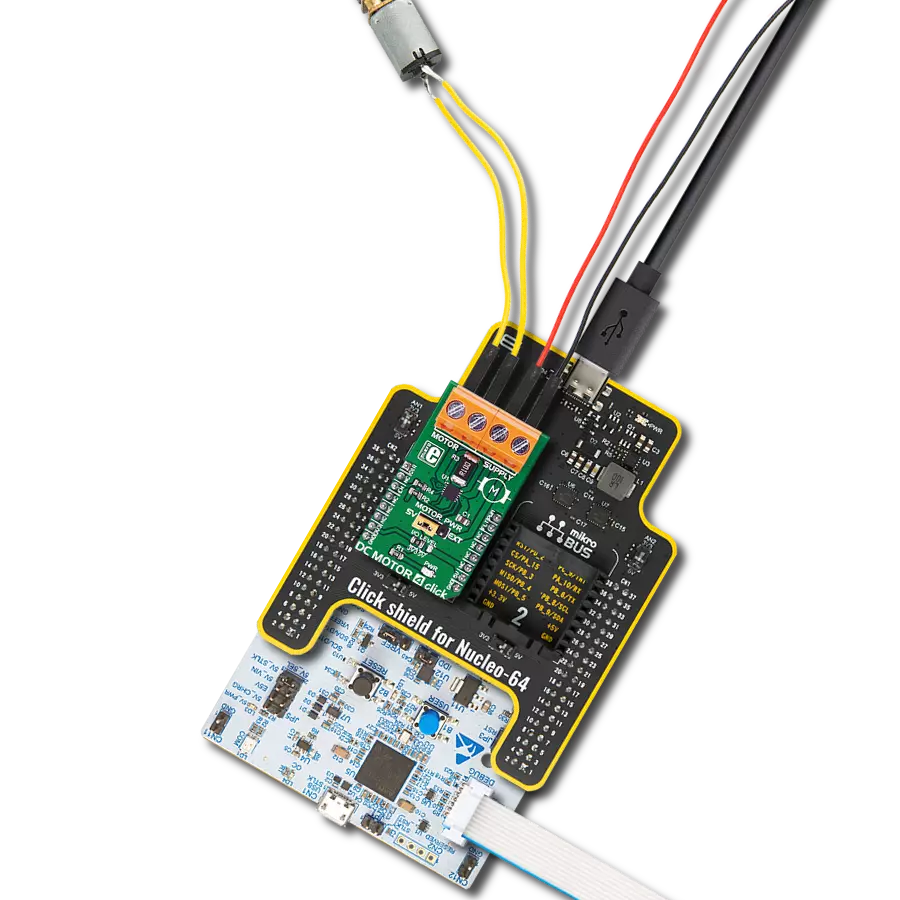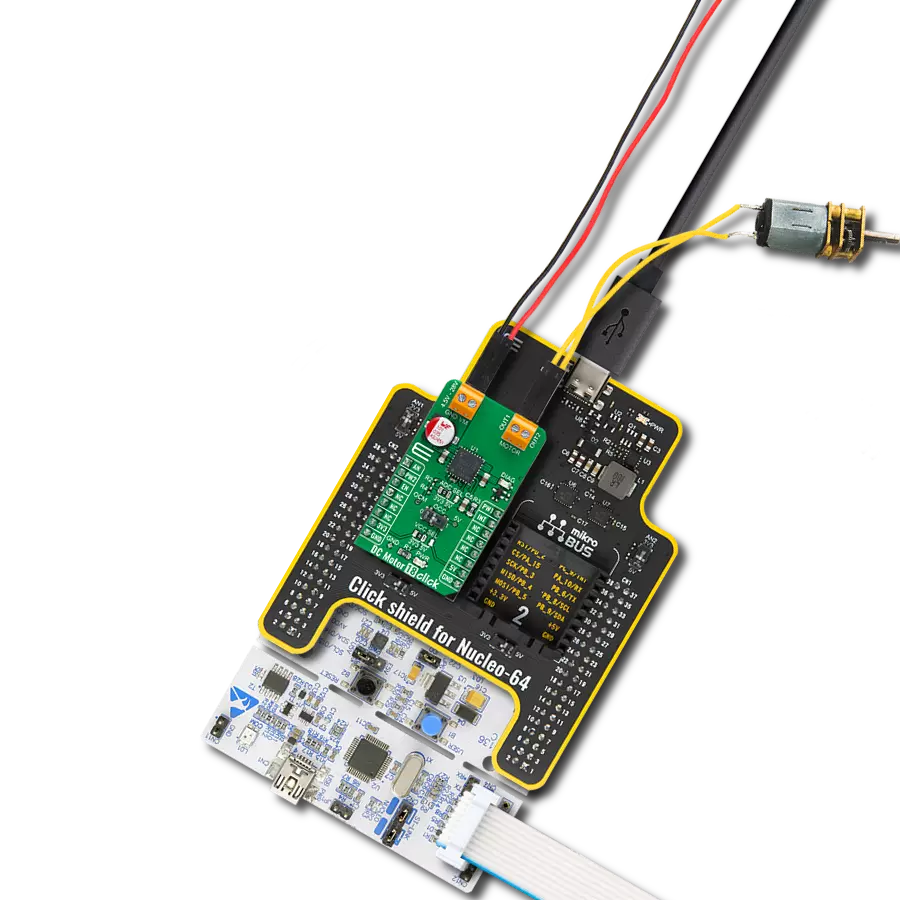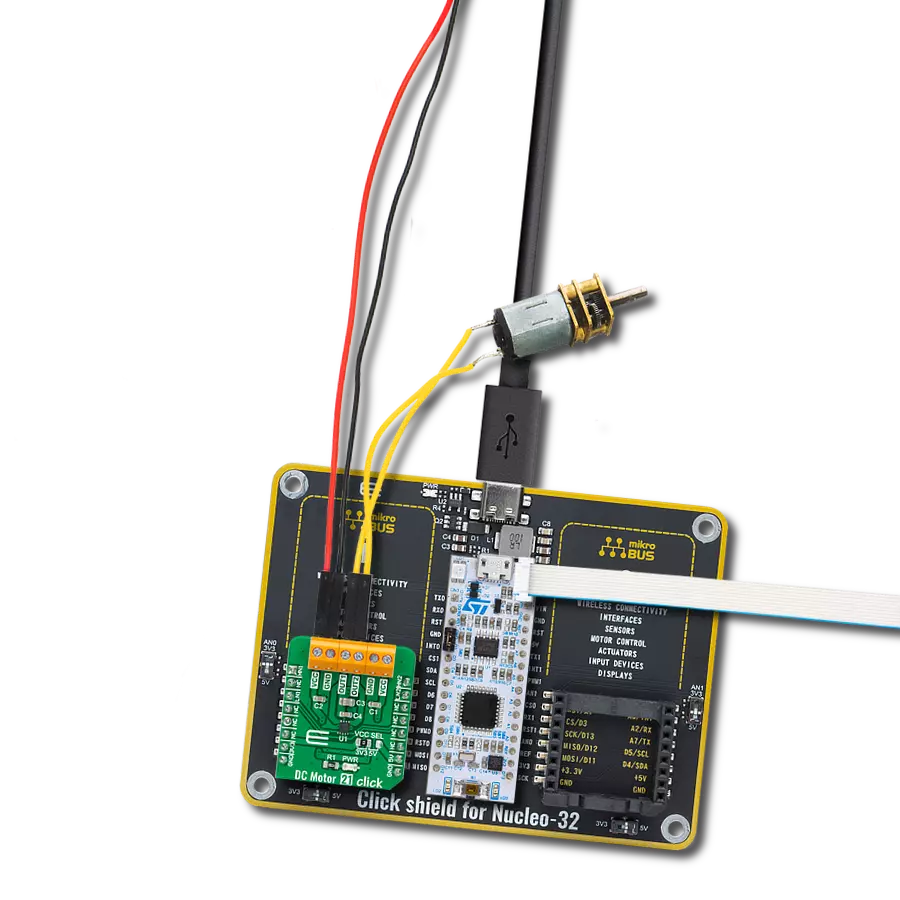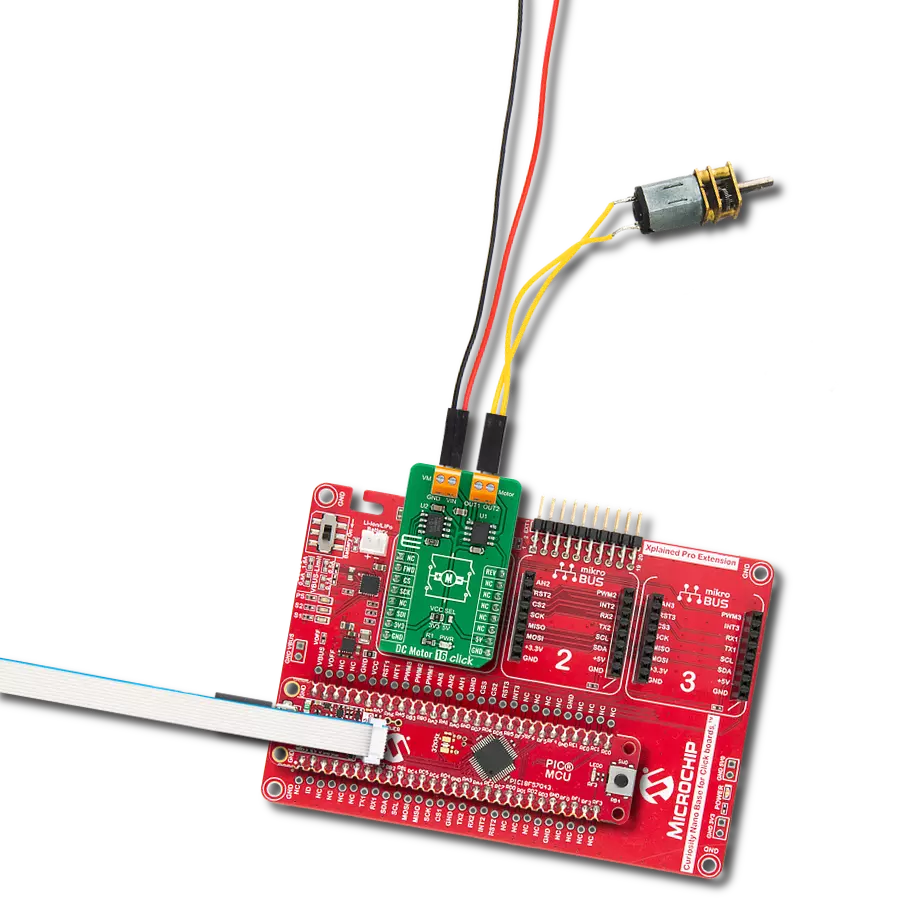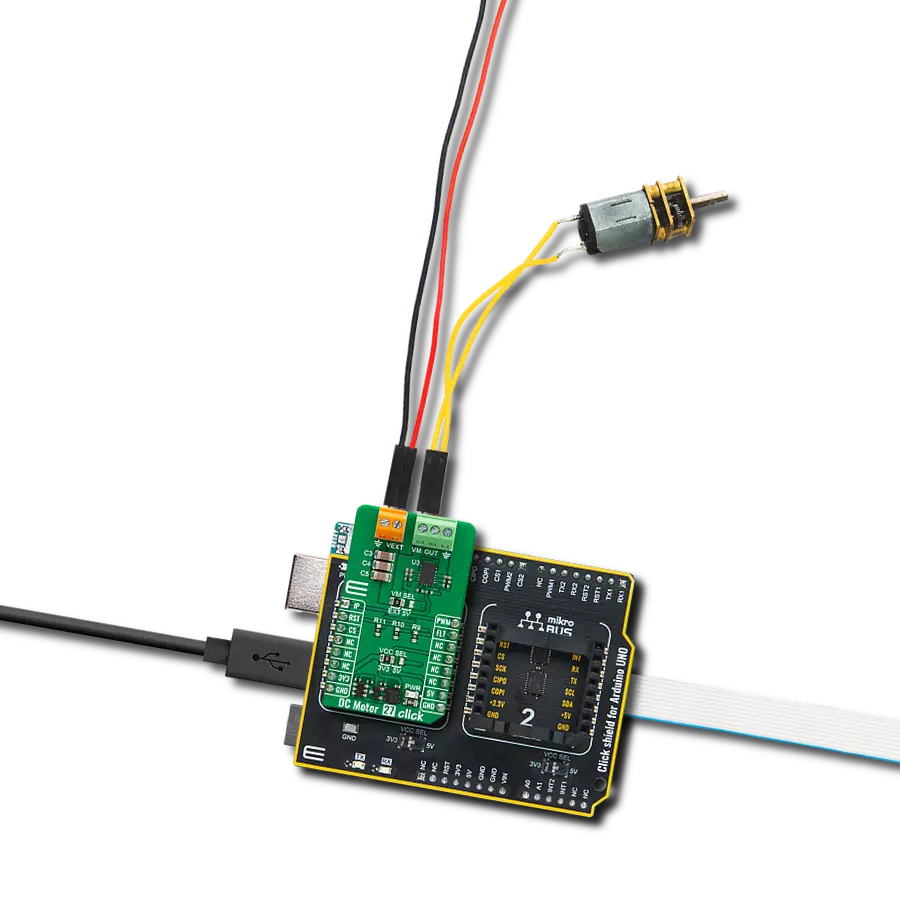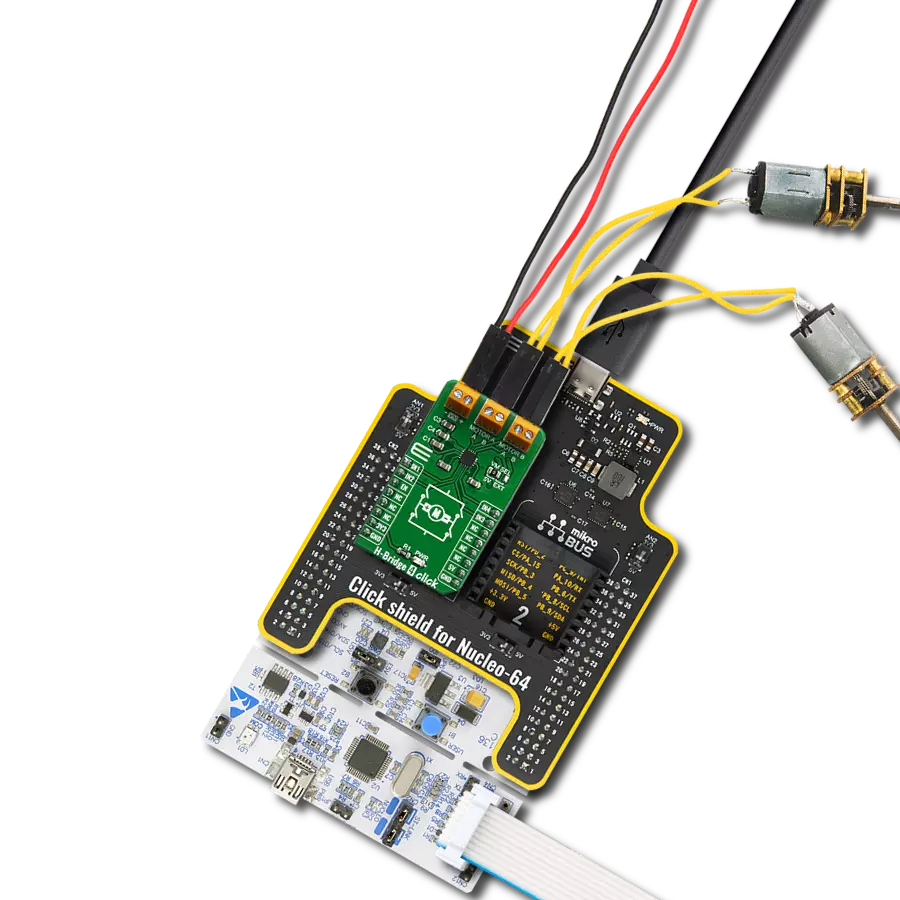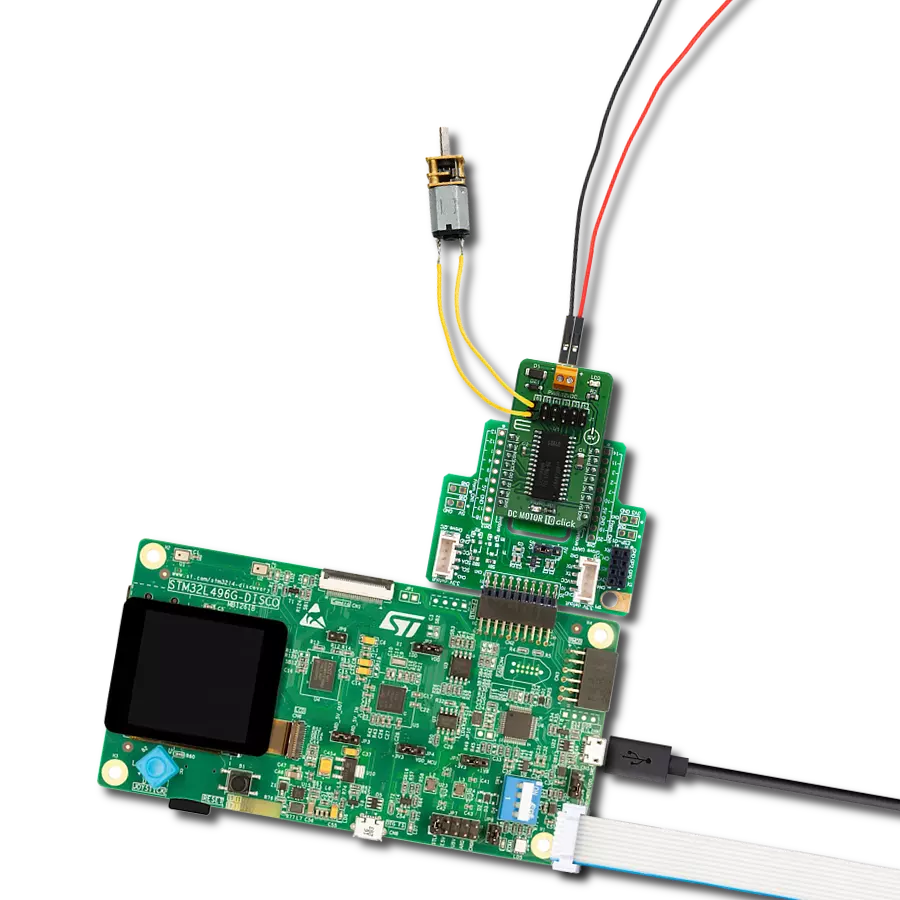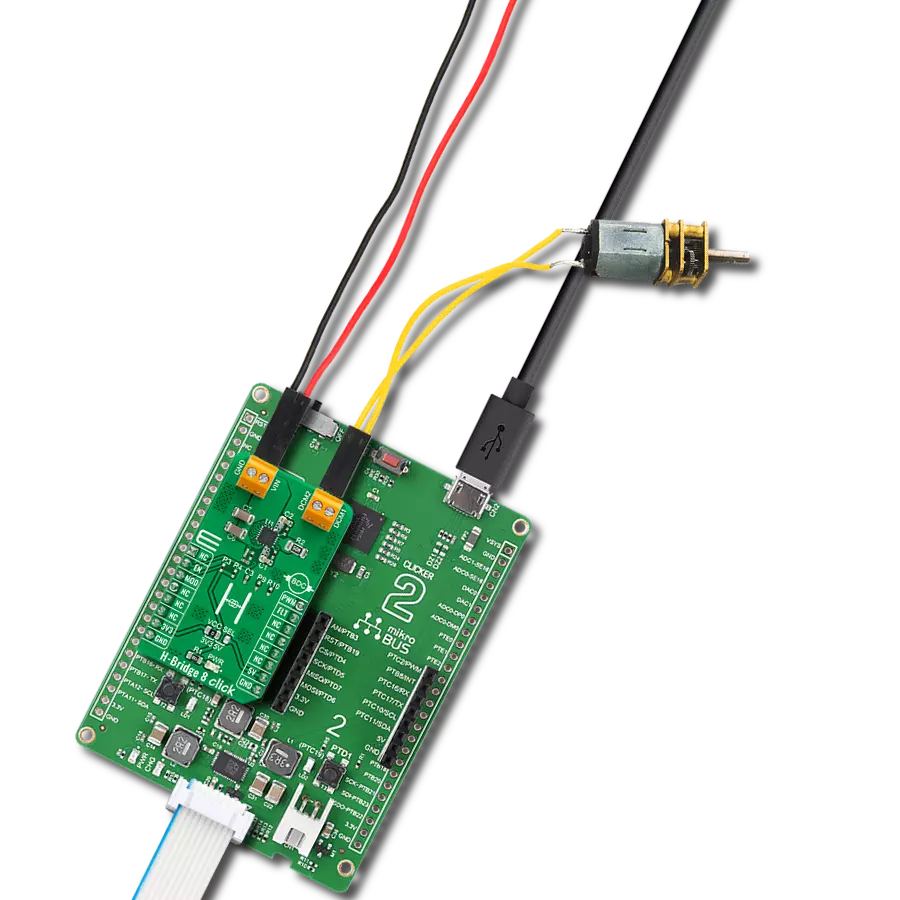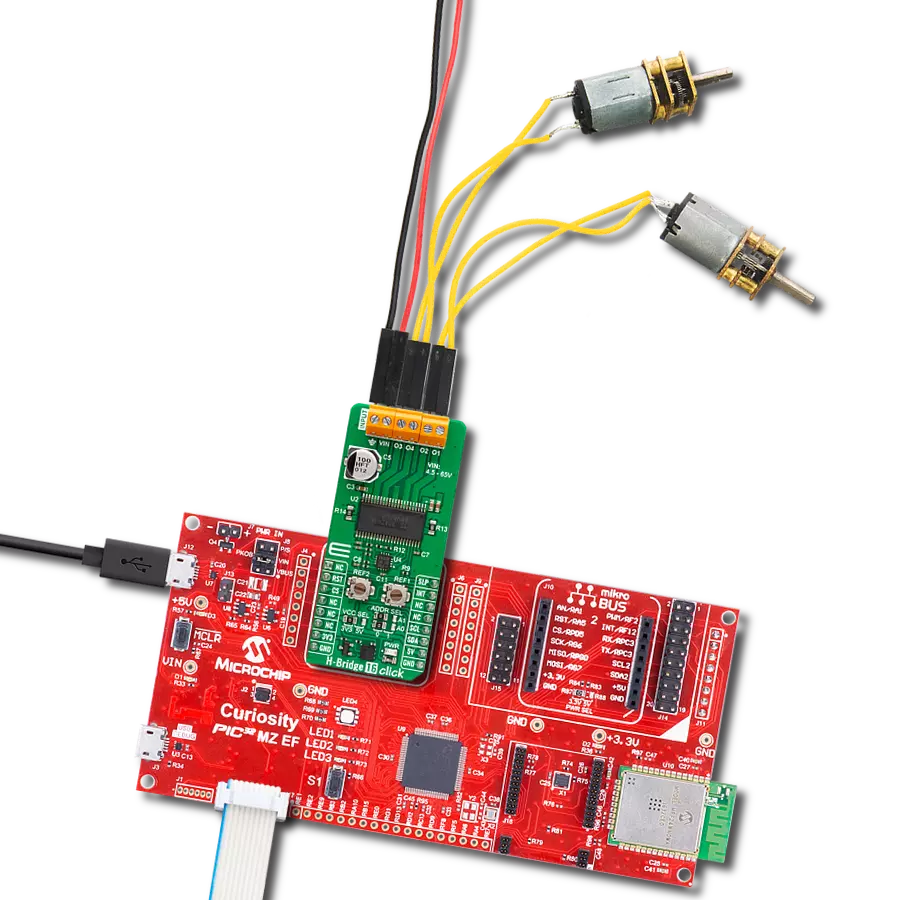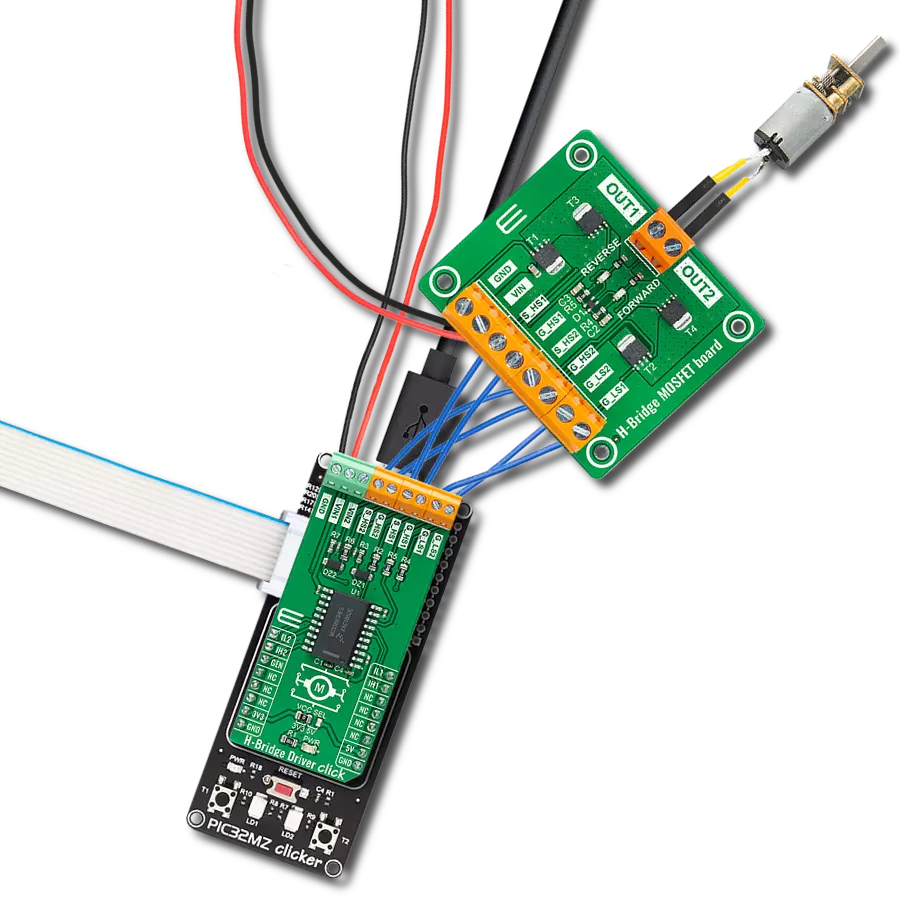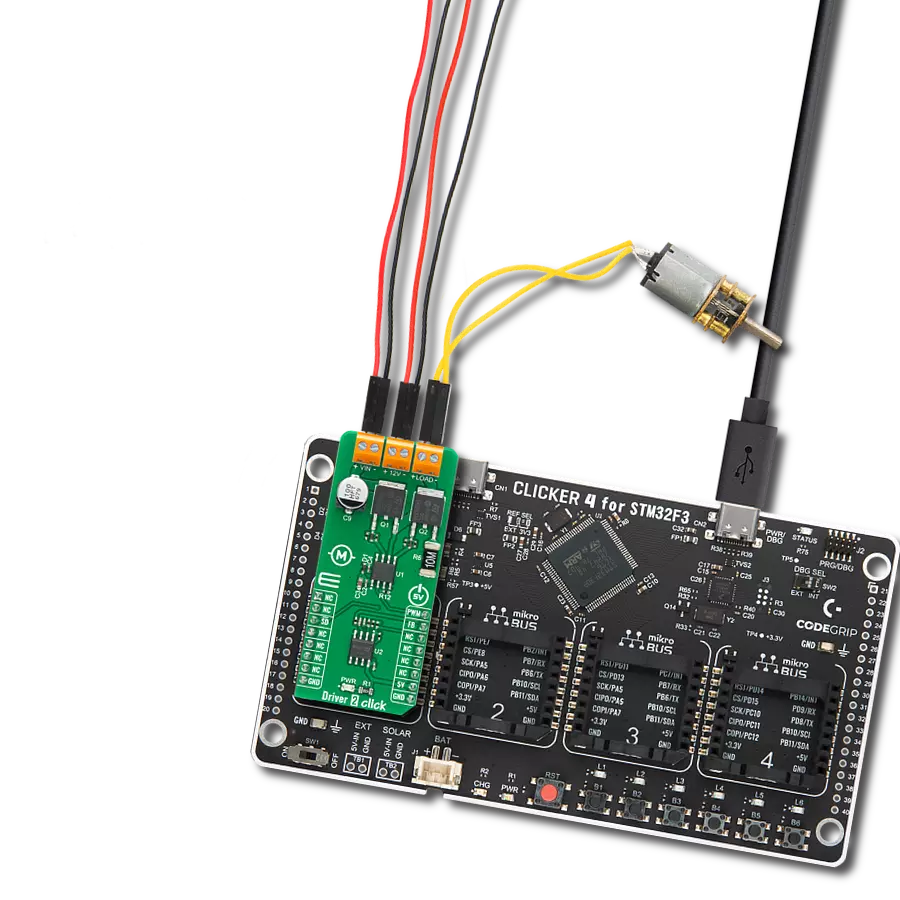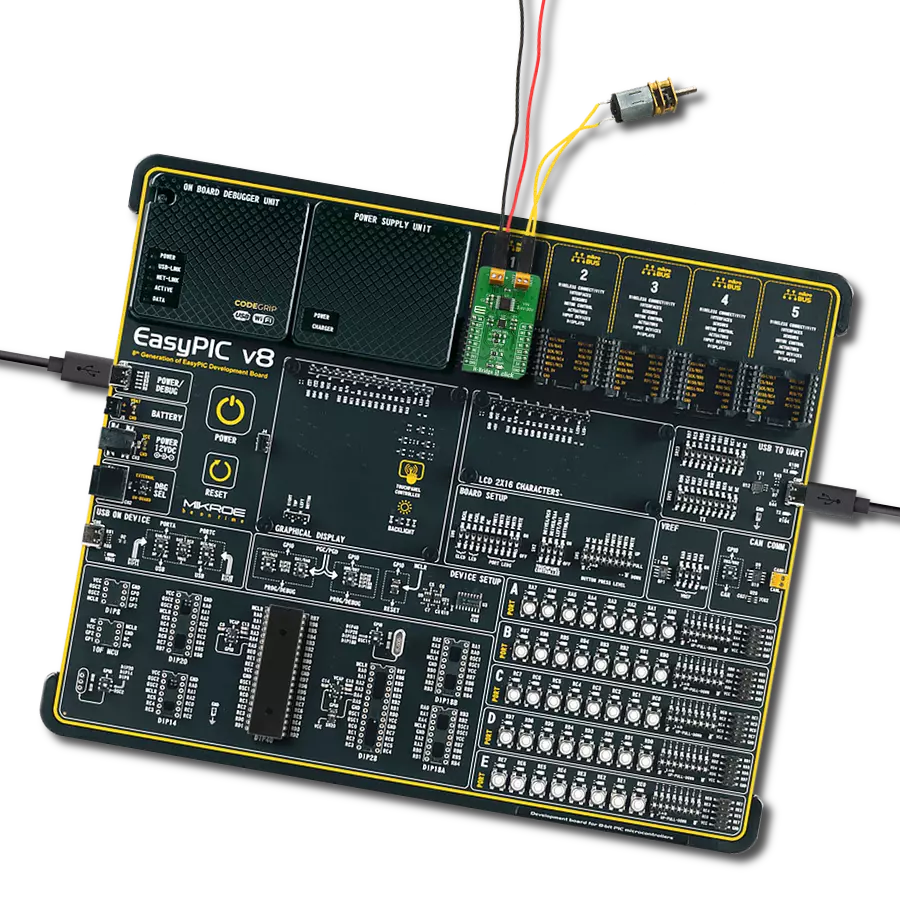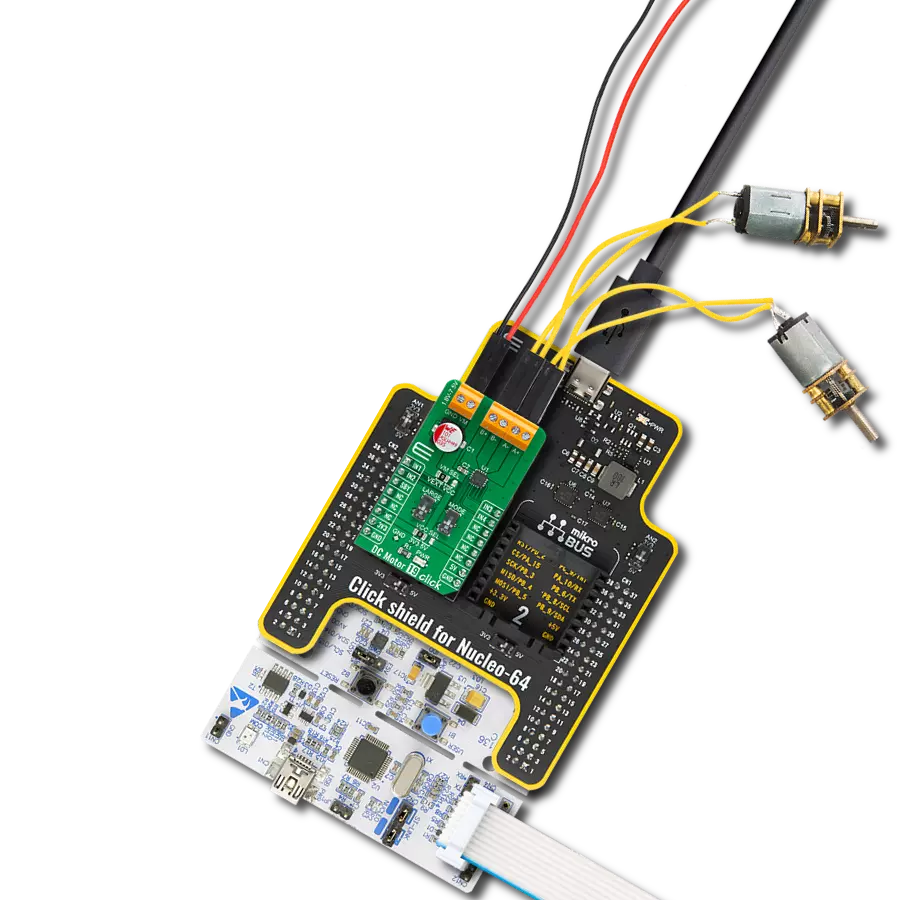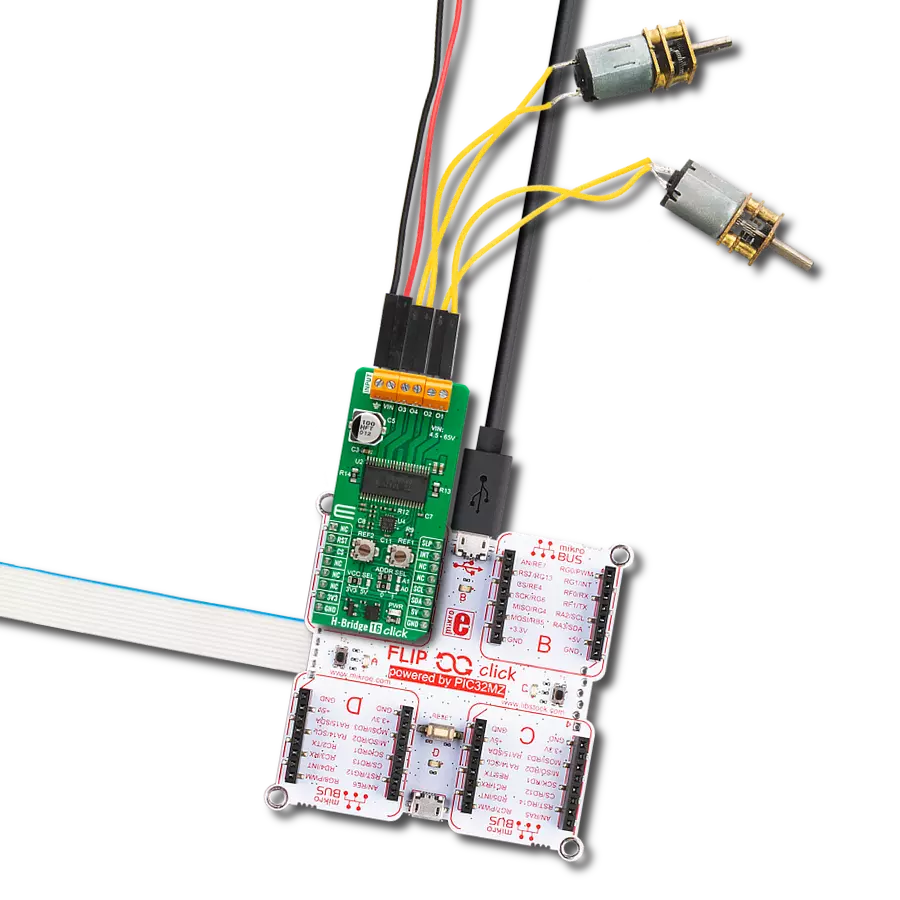Discover a seamless blend of power and reliability with our state-of-the-art DC brushed motor driver, empowering your creations like never before
A
A
Hardware Overview
How does it work?
DC Motor 24 Click is based on the L9958, a fully integrated motor driver for DC and stepper motors from STMicroelectronics used in safety-critical applications and under extreme environmental conditions. This Click board™ provides all the input and output capabilities necessary to drive DC or stepper motors (OUT terminal), alongside monitor diagnostic functions. The L9958 is rated for an operating voltage range from 4V to 28V (VIN terminal), with direct PWM motor control. The PWM control with simple direction control, DIR pin routed to the AN pin on the mikroBUS™ socket, allows MCU to manage the direction of the DC motor (clockwise or counterclockwise). This combination enables highly efficient motor drive
output, ensuring reliable operation for highly competitive automotive applications. This Click board™ communicates with MCU using a 4-wire SPI-compatible interface with a maximum frequency of 5MHz, for the configuration of the L9958. The SPI interface can set the current regulation threshold from 2.5A to 8.6A, typically in four steps (6.6A is a default). The L9958 also has detailed failure diagnostics on each channel provided via the SPI interface. The H-bridge is protected against temperature and short circuits and has an undervoltage/ overvoltage lockout for all the supply voltages. All malfunctions cause the output stages to go tri-state. The output can be turned off (set to tri-state) via a combination
of logic states of an onboard switch labeled as DI and enable pin routed to the EN pin on the mikroBUS™ socket. The internal H-bridge also contains integrated free-wheel diodes. In the case of the free-wheeling condition, the low-side transistor is switched ON in parallel to its diode to reduce power dissipation. This Click board™ can operate with either 3.3V or 5V logic voltage levels selected via the VCC SEL jumper. This way, both 3.3V and 5V capable MCUs can use the communication lines properly. The Click board™ comes equipped with a library containing easy-to-use functions and an example code that can be used, as a reference, for further development.
Features overview
Development board
Clicker 4 for STM32F4 is a compact development board designed as a complete solution that you can use to quickly build your own gadgets with unique functionalities. Featuring an STM32F407VGT6 MCU, four mikroBUS™ sockets for Click boards™ connectivity, power management, and more, it represents a perfect solution for the rapid development of many different types of applications. At its core is an STM32F407VGT6 MCU, a powerful microcontroller by STMicroelectronics based on the high-performance
Arm® Cortex®-M4 32-bit processor core operating at up to 168 MHz frequency. It provides sufficient processing power for the most demanding tasks, allowing Clicker 4 to adapt to any specific application requirements. Besides two 1x20 pin headers, four improved mikroBUS™ sockets represent the most distinctive connectivity feature, allowing access to a huge base of Click boards™, growing on a daily basis. Each section of Clicker 4 is clearly marked, offering an intuitive and clean interface. This makes working with the
development board much simpler and, thus, faster. The usability of Clicker 4 doesn’t end with its ability to accelerate the prototyping and application development stages: it is designed as a complete solution that can be implemented directly into any project, with no additional hardware modifications required. Four mounting holes [4.2mm/0.165”] at all four corners allow simple installation by using mounting screws.
Microcontroller Overview
MCU Card / MCU
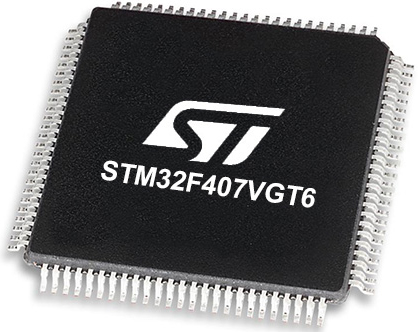
Architecture
ARM Cortex-M4
MCU Memory (KB)
10
Silicon Vendor
STMicroelectronics
Pin count
100
RAM (Bytes)
100
You complete me!
Accessories
DC Gear Motor - 430RPM (3-6V) represents an all-in-one combination of a motor and gearbox, where the addition of gear leads to a reduction of motor speed while increasing the torque output. This gear motor has a spur gearbox, making it a highly reliable solution for applications with lower torque and speed requirements. The most critical parameters for gear motors are speed, torque, and efficiency, which are, in this case, 520RPM with no load and 430RPM at maximum efficiency, alongside a current of 60mA and a torque of 50g.cm. Rated for a 3-6V operational voltage range and clockwise/counterclockwise rotation direction, this motor represents an excellent solution for many functions initially performed by brushed DC motors in robotics, medical equipment, electric door locks, and much more.
Used MCU Pins
mikroBUS™ mapper
Take a closer look
Click board™ Schematic

Step by step
Project assembly
Software Support
Library Description
This library contains API for DC Motor 24 Click driver.
Key functions:
dcmotor24_read_diag- This function reads a diagnostics word by using SPI serial interfacedcmotor24_switch_direction- This function switches the direction by toggling the DIR pin statedcmotor24_set_duty_cycle- This function sets the PWM duty cycle in percentages ( Range[ 0..1 ] )
Open Source
Code example
The complete application code and a ready-to-use project are available through the NECTO Studio Package Manager for direct installation in the NECTO Studio. The application code can also be found on the MIKROE GitHub account.
/*!
* @file main.c
* @brief DC Motor 24 Click example
*
* # Description
* This example demonstrates the use of the DC Motor 24 Click board by driving the
* motor in both directions at different speeds.
*
* The demo application is composed of two sections :
*
* ## Application Init
* Initializes the driver and performs the Click default configuration.
*
* ## Application Task
* Controls the motor speed by changing the PWM duty cycle every 500ms.
* The duty cycle ranges from 0% to 100%. At the minimal speed, the motor switches direction.
* It also reads and parses the diagnostics word register. Each step will be logged on
* the USB UART where you can track the program flow.
*
* @author Stefan Filipovic
*
*/
#include "board.h"
#include "log.h"
#include "dcmotor24.h"
static dcmotor24_t dcmotor24;
static log_t logger;
/**
* @brief DC Motor 24 display diag function.
* @details This function parses and displays a diagnostics word on the USB UART.
* @param[in] diag : Diagnostics word to parse and display.
* @return None.
* @note None.
*/
static void dcmotor24_display_diag ( uint16_t diag );
void application_init ( void )
{
log_cfg_t log_cfg; /**< Logger config object. */
dcmotor24_cfg_t dcmotor24_cfg; /**< Click config object. */
/**
* Logger initialization.
* Default baud rate: 115200
* Default log level: LOG_LEVEL_DEBUG
* @note If USB_UART_RX and USB_UART_TX
* are defined as HAL_PIN_NC, you will
* need to define them manually for log to work.
* See @b LOG_MAP_USB_UART macro definition for detailed explanation.
*/
LOG_MAP_USB_UART( log_cfg );
log_init( &logger, &log_cfg );
log_info( &logger, " Application Init " );
// Click initialization.
dcmotor24_cfg_setup( &dcmotor24_cfg );
DCMOTOR24_MAP_MIKROBUS( dcmotor24_cfg, MIKROBUS_1 );
if ( SPI_MASTER_ERROR == dcmotor24_init( &dcmotor24, &dcmotor24_cfg ) )
{
log_error( &logger, " Communication init." );
for ( ; ; );
}
if ( DCMOTOR24_ERROR == dcmotor24_default_cfg ( &dcmotor24 ) )
{
log_error( &logger, " Default configuration." );
for ( ; ; );
}
log_info( &logger, " Application Task " );
}
void application_task ( void )
{
static int8_t duty_pct = 10;
static int8_t duty_step = 10;
uint16_t diag;
if ( DCMOTOR24_OK == dcmotor24_set_duty_cycle ( &dcmotor24, ( float ) duty_pct / 100 ) )
{
log_printf( &logger, "\r\n Duty: %u%%\r\n", ( uint16_t ) duty_pct );
}
if ( DCMOTOR24_OK == dcmotor24_read_diag ( &dcmotor24, &diag ) )
{
dcmotor24_display_diag ( diag );
}
Delay_ms ( 500 );
if ( ( 100 == duty_pct ) || ( 0 == duty_pct ) )
{
duty_step = -duty_step;
if ( 0 == duty_pct )
{
log_printf( &logger, "\r\n Switch direction\r\n" );
dcmotor24_switch_direction ( &dcmotor24 );
Delay_ms ( 500 );
}
}
duty_pct += duty_step;
}
int main ( void )
{
/* Do not remove this line or clock might not be set correctly. */
#ifdef PREINIT_SUPPORTED
preinit();
#endif
application_init( );
for ( ; ; )
{
application_task( );
}
return 0;
}
static void dcmotor24_display_diag ( uint16_t diag )
{
log_printf( &logger, " --- Diagnostics ---\r\n" );
if ( diag & DCMOTOR24_DIA_OL_OFF )
{
log_printf( &logger, " * Open Load in OFF condition\r\n" );
}
if ( diag & DCMOTOR24_DIA_OL_ON )
{
log_printf( &logger, " * Open Load in ON condition\r\n" );
}
if ( diag & DCMOTOR24_DIA_VS_UV )
{
log_printf( &logger, " * Vs undervoltage\r\n" );
}
if ( diag & DCMOTOR24_DIA_VDD_OV )
{
log_printf( &logger, " * Vdd overvoltage\r\n" );
}
if ( diag & DCMOTOR24_DIA_ILIM )
{
log_printf( &logger, " * Current Limitation reached\r\n" );
}
if ( diag & DCMOTOR24_DIA_TWARN )
{
log_printf( &logger, " * Temperature warning\r\n" );
}
if ( diag & DCMOTOR24_DIA_TSD )
{
log_printf( &logger, " * Over-temperature Shutdown\r\n" );
}
if ( diag & DCMOTOR24_DIA_ACT )
{
log_printf( &logger, " * Bridge enable\r\n" );
}
if ( diag & DCMOTOR24_DIA_OC_LS1 )
{
log_printf( &logger, " * Over-Current on Low Side 1\r\n" );
}
if ( diag & DCMOTOR24_DIA_OC_LS2 )
{
log_printf( &logger, " * Over-Current on Low Side 2\r\n" );
}
if ( diag & DCMOTOR24_DIA_OC_HS1 )
{
log_printf( &logger, " * Over-Current on High Side 1\r\n" );
}
if ( diag & DCMOTOR24_DIA_OC_HS2 )
{
log_printf( &logger, " * Over-Current on High Side 2\r\n" );
}
if ( diag & DCMOTOR24_DIA_SGND_OFF )
{
log_printf( &logger, " * Short to GND in OFF condition\r\n" );
}
if ( diag & DCMOTOR24_DIA_SBAT_OFF )
{
log_printf( &logger, " * Short to Battery in OFF condition\r\n" );
}
}
// ------------------------------------------------------------------------ END
Additional Support
Resources
Category:Brushed


















